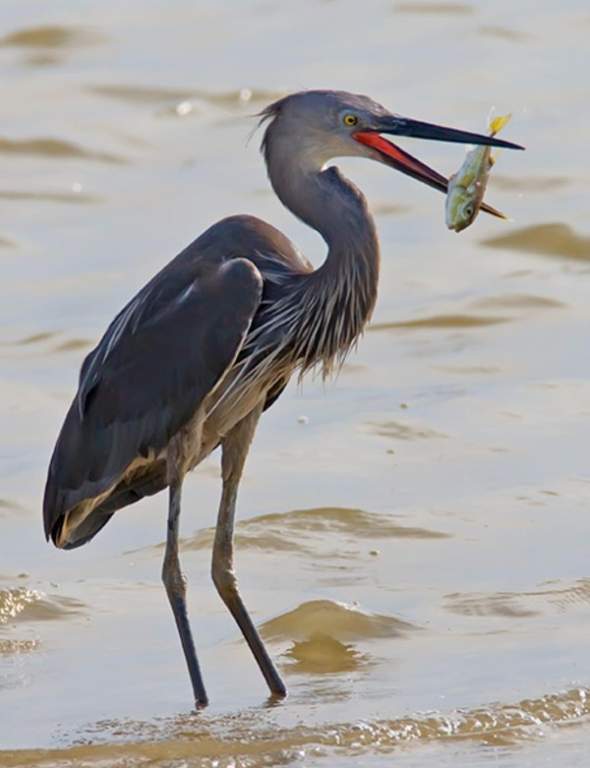Family: The great-billed heron (Ardea sumatrana) is a member of the heron family Ardeidae in the genus Ardea.
Habitat: Most of its habitats are around the coast, including mangroves, islands, coral reefs, and big rivers; on rare occasions, it may be found inland in shallow ponds. The skulking great-billed heron keeps to the mangrove-lined waterways of coastal northern Australia. It stalks stealthily along the mud flats exposed by the tide and in the shallows of nearby lagoons, feeding on various aquatic animals as large as catfish and crabs. At high tide, it rests perched in the mangroves, flying into them with the lumbering, head-retracted flight characteristic of all the herons. A resonant roar lasting several seconds, maybe repeated irregularly by nesting birds. In alarm, they croak.
Identification: Both adult sexes are similar. The general plumage is uniform brown-grey; fangs of silver-grey nuptial plumes on the nape and back; persistent plumes on the breast. The throat is white. The naked skin in front of the eye is olive-yellow. Eyes are yellow. The bill is black and yellow at the base of the mandible. Legs and feet are dusky grey. The immature bird’s general plumage is uniformly rust-brown. No nuptial plumes.

Behavior: The great-billed heron seems to pair permanently and hold a foraging territory of riverfront in which there may be three to seven nests, any one of which may be used for breeding and the others for roosting. Its look is similar to that of the purple heron, but it is larger and darker. In what may be courtship, male and female fan and cock their short tails, puff up their neck hackles, and raise a small crest. Drooping wings touch the ground as the pair strut around, bowing to one another and dancing a few steps. At least one of the birds drums like a small engine. Although two eggs often form a clutch, one young is usually reared.
Flight: The flight of herons and bitterns is sluggish, with the neck retracted; this sets them apart from storks, cranes, and spoonbills, who stretch their necks.
Vocalizations: The great-billed heron calls in guttural notes; a loud croak in alarm; an irregular resonant roaring at the nest.
Diet: The great-billed heron waits immobility for its prey or stalks its target slowly. It feeds in shallow water, spearing fish with its long, sharp bill.
Nesting and Breeding: Great-billed heron nesting and breeding occur throughout the year, however, mostly depending on food availability. Nest about 1.3 meters in diameter by about 0.5 meters deep. The nest is a platform of sticks built up to 6 m above ground in a tree. Most nests are placed in mangroves inundated with up to one meter of water at high tide. Established pairs may not breed every year.
Eggs and Incubation: The bird lays 2 eggs, pale blue-green and oval, about 69 x 48 mm, incubated by both sexes.
Other Names: This wading bird is also known as the alligator bird.
Size: The great-billed heron measures about 1050 mm in length, weighing up to 2.6 kg.
Distribution: The great-billed heron is found in mud flats, estuaries, lagoons, rivers, and dense mangroves of northern Australia, Papua New Guinea, Indonesia, and southeastern Asia. Rather solitary; nowhere common.
Races: There are no races
Read More: White-faced heron (Egretta novaehollandiae)
